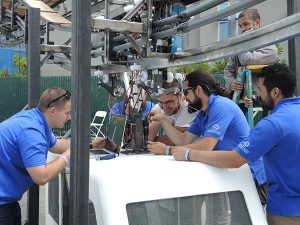
Photo: Lisa Francesca
SJSU students work on a Spartan Superway project as part of the Engineering Projects in Community Service (EPICS) course.
Adapted from the Charles W. Davidson College of Engineering Spring 2017 “Engineering for Good” Alumni Magazine article by Lisa Francesca, communications specialist
San Jose State University’s Charles W. Davidson College of Engineering launched a pilot of an Engineering Projects in Community Service (EPICS) course in 2016 to provide service learning and project-based opportunities to undergraduate students. Originally started at Purdue University 20 years ago, the EPICS program is now offered at more than 25 universities. The student teams are interdisciplinary and work for real-world nonprofit clients to solve a community concern.
Dr. Jinny Rhee, the associate dean for undergraduate students in the College of Engineering, initiated the program last spring.
“A study by CSU Northridge showed that involvement in community service increases both retention and graduation rates in engineering programs,” she said. “This was a profound motivation for us to start the program, and now we are realizing even more benefits. Students become involved with authentic problems and build valuable connections with members of local industry and nonprofit communities. And it provides them with opportunities to mentor each other.”
One team developed a software program called “Study Buddy” that will allow computer science students to text questions to IBM’s supercomputer Watson and receive answers.
“I’m so excited about this project,” said Joey Richardson, ’16 Computer Engineering. “We are creating a completely new technology. We are training Watson to learn computer science so it can answer the questions. That means we have to supply all the information to Watson as well as devise the questions that first and second-year students are likely to ask. We are manipulating our knowledge so Watson can help anyone to study successfully.”
A second team continued through 2017 with a project started by students in the spring 2016 pilot program. The students are working to convert an old shipping container into a mobile shower and laundry facility for the homeless. The initial team moved the container from the Port of Oakland to the Engineering building courtyard by outfitting it with axles, wheels and a hitch. They installed the initial shower and laundry fixtures, attaching solar panels to it. This year’s team is working on adding insulation to the unit that is equipped to provide showers to 14 clients a day. The students received donations from the Gilroy Compassion Center, SJSU and Sunpower, and also launched a GoFundMe campaign.
Another set of students is working on creating an electric vehicle charger with parameters set by Dr. Fred Barez, the chair of Aviation and Technology.
“We’ve been learning all about restrictions,” said Daniel Khawaja, ’16 Computer Engineering. “We don’t get to design whatever we want – it’s what he wants. It would be much easier to design a solution for a ‘fun’ problem. But it’s exciting, too. We’ve been able to get critiques, ideas and help from industry professionals.”
The program is expanding to include an upper and lower division course so seniors will have an opportunity to mentor peers while first-year students will have a chance to do relevant community service, according to Keith Perry, the professor who is teaching the class.